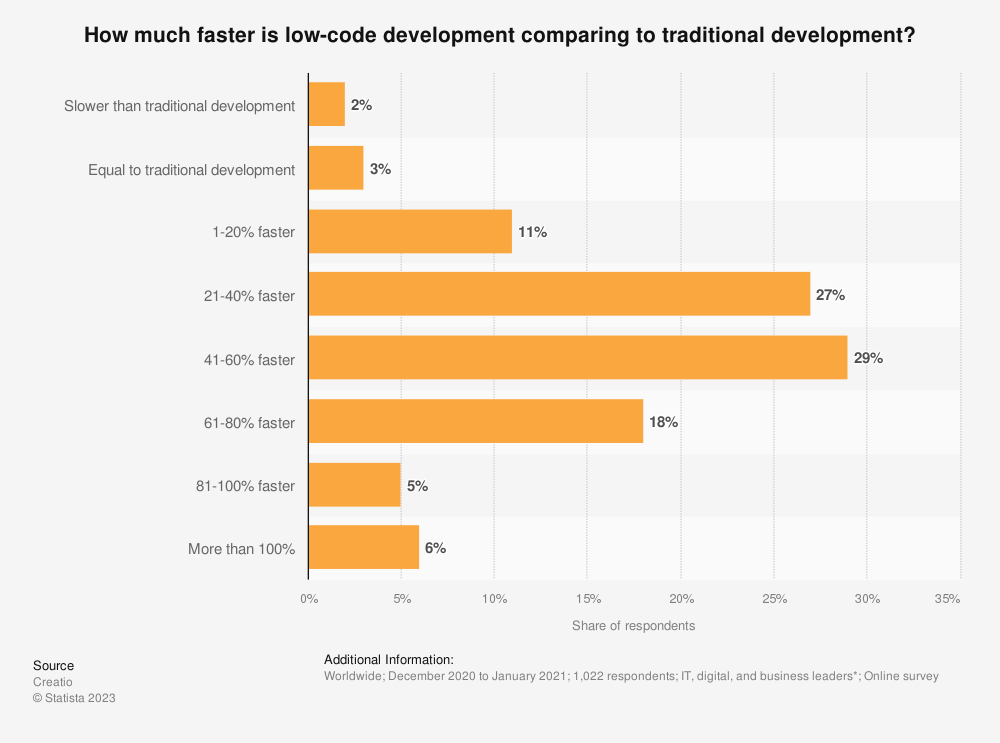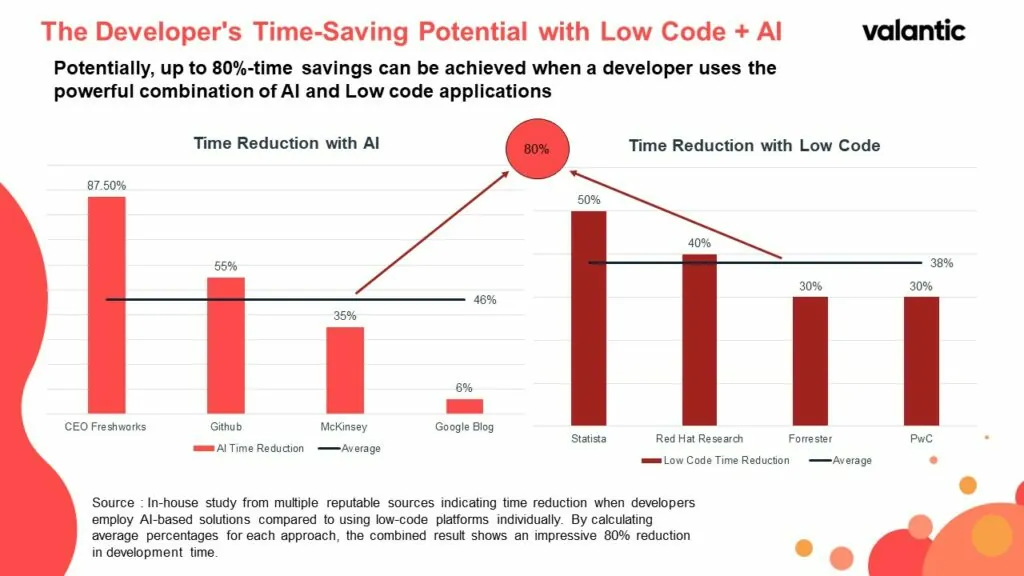Win Win: Low-Code Plus AI Saves Time by up to 80 Percent
August 14, 2023

August 14, 2023

Low-Code and Artificial Intelligence (AI) technologies are increasingly establishing themselves as the performance boosters of software development. Used judiciously, they lure with huge efficiency gains and time savings of 40 to 80 percent, and more, depending on the project and use case. “We use ChatGPT to write code,” says Girish Mathrubootham, founder and CEO of software company Freshworks. “Our software projects used to take eight to ten weeks on average. With ChatGPT, we now get the job done in under a week,” Girish stresses.
”Our software projects used to take eight to ten weeks on average. With ChatGPT, we now get the job done in under a week.“
Girish Mathrubootham, CEO Freshworks
Greg Jackson, CEO of Octopus Energy, is similarly elated with his experience with AI. “Artificial intelligence is doing the work of hundreds of employees at our company. Emails written by AI tools are received more enthusiastically by our customers and boost customer satisfaction compared to correspondence written by human employees,” Greg has observed. Octopus Energy is a British energy utility that provides businesses with green energy, gas and heat pumps and has a subsidiary in Munich.
”Artificial intelligence is doing the work of hundreds of employees at our company . Emails written by AI tools are received more enthusiastically by our customers and boost customer satisfaction compared to correspondence written by human employees.“
Greg Jackson, CEO of Octopus Energy
AI offers the potential for huge time savings and efficiency gains. When combined with low-code/no-code software development platforms, the business benefits increase even further. The research portal Statista asked CIOs and IT specialists about the performance gains that can be achieved using low-code/no-code platforms alone. The result: 89 percent of the respondents believe that use of these platforms can significantly increase the efficiency of software development compared to traditional software development methods.

The conclusion was that generative AI gives an additional performance boost to the already high-performance low-code/no-code development platforms. The coding capabilities of generative AI had a particularly positive impact on the work of experienced software developers working on longer, time-consuming projects and seeking quick and efficient means of completing non-complex programming tasks, believes Hyon Park, Principal Analyst at Amalgam Insights. Hyon estimates that this will double the market for low-code platforms over the next 18 to 24 months.
Digital.Now has evaluated the surveys and research findings of reputable sources such as PriceWaterhouseCoopers, McKinsey, Forrester and Statista, to calculate precisely, and on a broad factual basis, the time savings expected through the use of low-code and AI. Statista estimates the highest time savings through low-code platforms at 50 percent, based on the results of a global survey of more than 1,000 decision-makers conducted by Creatio (see chart above).
PriceWaterhouseCoopers (PwC) reaches a more conservative but still impressive conclusion. PwC set up a “multitenant enterprise decision support website” based on the Microsoft Power platform and has achieved cost savings of 85 percent and time savings of 30 percent since implementation. Taking into account research findings of Red Hat Research (40%) and Forrester (30%), Digital.Now puts the average time savings through the use of low-code platforms at 38 percent.
When using artificial intelligence, the potential time savings are even more impressive. Girish Mathrubootham from Freshworks (see beginning of article) achieved extremely impressive savings of 87.5 percent. Naturally, however, the time savings achievable through the use of AI also depend decisively on the complexity of the software projects and the developers’ expertise, i.e. on the individual software project concerned. Depending on the case at hand, they can thus be lower, but also higher. Together with the more modest saving potentials of Github (55%), McKinsey (35%) and Google (6%), Digital.Now calculates an average time saving of 46 percent through using AI.
According to Digital.Now’s research and calculations, software developers and architects who use low-code and AI technologies in tandem – i.e., together – can expect time savings of up to 80 percent.

Besides the calculated time savings, companies that use AI in low-code development realize six further benefits in particular:
OpenAI’s generative AI ChatGPT was launched in November 2022 and quickly became a worldwide success. The combination of the two technologies ChatGPT/AI and low-code/no-code, however, still remains largely uncharted territory.
Companies that wish to leverage the efficiency and performance potential of AI and low-code in tandem should proceed as follows:
Systematic performance monitoring and regular user feedback help companies continuously improve their use of AI and low-code.
Software decision-makers wishing to benefit from the combination of low-code and AI should first explore the features of the low-code platforms they are considering. Platforms that support AI include Outsystems, Appian and Microsoft PowerApps. And since integrating conversational AI tools such as ChatGPT into your programming requires a minimum of expertise and practice, and the initial hurdles have been successfully overcome, the combination of low-code plus AI software not only lets developers create better code faster, they also have more fun doing so.

Elevate Your Business with our AI Consulting Services!
At valantic, we understand that embarking on an AI journey can be both exciting and daunting. Our AI consulting services are designed to guide you through every step of this…
Don't miss a thing.
Subscribe to our latest blog articles.